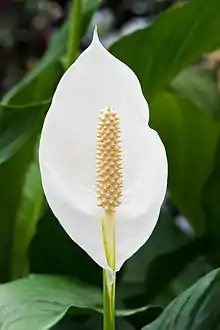Spathiphyllum
Spathiphyllum is a genus of about 47 species of monocotyledonous flowering plants in the family Araceae, native to tropical regions of the Americas and southeastern Asia. Certain species of Spathiphyllum are commonly known as spath or peace lilies.
| Spathiphyllum | |
|---|---|
 | |
| Spathiphyllum cochlearispathum | |
| Scientific classification | |
| Kingdom: | Plantae |
| Clade: | Tracheophytes |
| Clade: | Angiosperms |
| Clade: | Monocots |
| Order: | Alismatales |
| Family: | Araceae |
| Subfamily: | Monsteroideae |
| Tribe: | Spathiphylleae |
| Genus: | Spathiphyllum Schott |
 | |
| Map of the natural distribution | |
| Synonyms[1] | |
| |
They are evergreen herbaceous perennial plants with large leaves 12–65 cm long and 3–25 cm broad. The flowers are produced in a spadix, surrounded by a 10–30 cm long, white, yellowish, or greenish spathe. The plant does not need large amounts of light or water to survive.
Etymology
Schott's description of the genus refers to Spatha foliaris persistens,[2] where spatha is a spathe, and foliaris is an adjective modifying spathe, meaning relating to a leaf, and persistens means continuing or persisting. Phyllum also means a leaf.[3]
Selected species
Species include:[4]
- Spathiphyllum atrovirens
- Spathiphyllum bariense
- Spathiphyllum blandum
- Spathiphyllum brevirostre
- Spathiphyllum cannifolium
- Spathiphyllum cochlearispathum
- Spathiphyllum commutatum
- Spathiphyllum cuspidatum
- Spathiphyllum floribundum
- Spathiphyllum friedrichsthalii
- Spathiphyllum fulvovirens
- Spathiphyllum gardneri
- Spathiphyllum grandifolium
- Spathiphyllum jejunum
- Spathiphyllum juninense
- Spathiphyllum kalbreyeri
- Spathiphyllum kochii
- Spathiphyllum laeve
- Spathiphyllum lechlerianum
- Spathiphyllum maguirei
- Spathiphyllum mawarinumae
- Spathiphyllum monachinoi
- Spathiphyllum montanum
- Spathiphyllum neblinae
- Spathiphyllum ortgiesii
- Spathiphyllum patini
- Spathiphyllum perezii
- Spathiphyllum phryniifolium
- Spathiphyllum quindiuense
- Spathiphyllum silvicola
- Spathiphyllum solomonense
- Spathiphyllum wallisii
- Spathiphyllum wendlandii
Cultivated hybrids include:[5]
- Spathiphyllum × clevelandii
Cultivation and uses
Several species are popular indoor houseplants. It lives best in shade and needs little sunlight to thrive, and is watered approximately once a week. The soil is best left moist but only needs watering if the soil is dry. The NASA Clean Air Study found that Spathiphyllum cleans certain gaseous environmental contaminants, including benzene and formaldehyde.[6] However, subsequent tests have shown this cleaning effect is far too small to be practical.[7]
Toxicity
Although it is called a "lily", the peace lily is not a true lily from the family Liliaceae. True lilies are highly toxic (poisonous) to cats and dogs,[8][9] but the peace lily, spathiphyllum is only mildly toxic to humans and other animals when ingested.[10][11] It contains calcium oxalate crystals, which can cause skin irritation, a burning sensation in the mouth, difficulty swallowing, and nausea,[12] but it does not contain the toxins found in true lilies, which could cause acute kidney failure in cats and some other animals.[13]
See also
- Anthurium, similar looking genus of plants in same family
- List of plants known as lily
References
- "Kew World Checklist of Selected Plant Families". Apps.kew.org. Retrieved 2018-07-12.
- Heinrich Wilhelm Schott and Stephan Endlicher (1832). Meletemata botanica. C. Gerold, made available online by The Biodiversity Heritage Library.
- Stearn, W. T. (1992). Botanical Latin: History, grammar, syntax, terminology and vocabulary, Fourth edition. David and Charles.
- "Search results — The Plant List". www.theplantlist.org.
- Edward F. Gilman (1999). "Spathiphyllum x 'Clevelandii', Fact Sheet FPS-555" (PDF). University of Florida Cooperative Extension Service.
- Anne Raver (February 13, 1994). "Need an Air Freshener? Try Plants". New York Times.
- "Which houseplants should you buy to purify air? None of them". National Geographic. November 17, 2019.
- Fitzgerald, Kevin T. (2010). "Lily Toxicity in the Cat". Topics in Companion Animal Medicine. 25 (4): 213–217. doi:10.1053/j.tcam.2010.09.006. ISSN 1938-9736. PMID 21147474.
- "Peace Lily". Retrieved 1 August 2016.
- "University of California - Toxic Plants (list)". Archived from the original on 2010-01-31. Retrieved 2018-07-12.
- "23 Common Flowers That Are Poisonous For Your Pet". www.entirelypets.com.
- "Toxic and Non-Toxic Plants - Peace Lily". Retrieved 1 August 2016.
- "Peace Lily Are Toxic To Pets". Pet Poison Helpline.
External links
| Wikimedia Commons has media related to Spathiphyllum. |
| Wikispecies has information related to Spathiphyllum. |